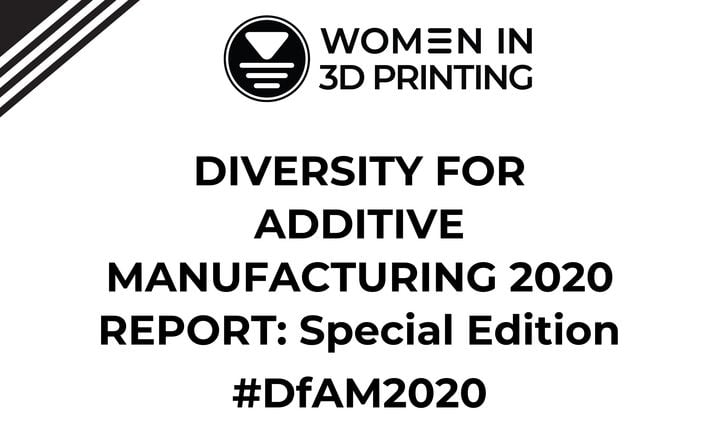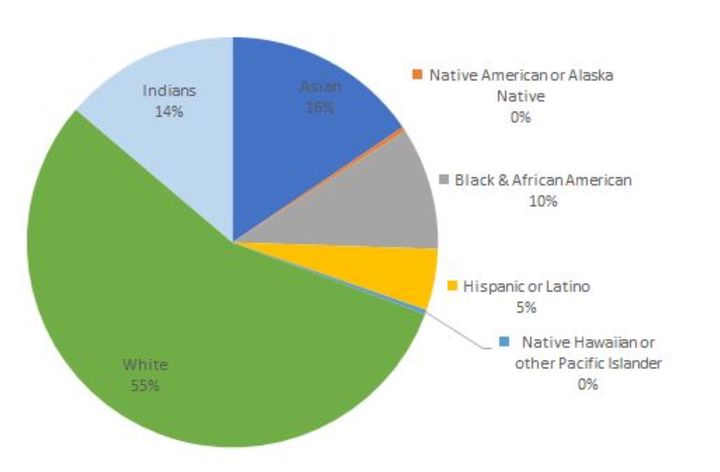
Women in 3D Printing’s 2020 Diversity for Additive Manufacturing report is a special edition, and it’s something everyone should read.
If you’re not familiar with Women in 3D Printing, it is a non-profit global organization that, as you might guess, was originally founded to promote the participation of women in the world of 3D printing. At that time, and still today, women are a small minority of those you’ll encounter in the space.
Wi3DP has for a few years now been releasing Diversity for Additive Manufacturing (DfAM) reports that focus on the expanding diversity in this industry, starting with gender parity. For this special edition of the report, they have shifted their mandate to a more general focus on inclusion. While women are certainly a disadvantaged group in 3D printing, there are many other groups in a similar position. Their latest report focuses on diversity in general within the workplace.
Our own Managing Editor, Sarah Goehrke, authored the first several Wi3DP DfAM reports, working with Wi3DP Founder Nora Toure. Given the events of a racially-divisive 2020, though, they decided to create a special edition of the report that broadens the perspective of diversity in honor of the Black Lives Matter movement and understanding of the importance of diversity and inclusion. Kety Sindze, Managing Editor of 3D Adept media, led the report this time around, with perspective included throughout from Erika Jefferson, President and Founder of Black Women in Science and Engineering (BWISE).
This year Wi3DP undertook an interesting survey of several recruiting and 3D print companies located on both sides of the Atlantic to learn more about how diversity is created and maintained. The report not only analyzes the survey results, but also provides some tips on how companies can approach the issue in a sensible and practical manner.
One challenge faced by the report authors was the meaning of “diversity”. While this could be said to be the inclusion of “under-represented groups”, the definition of that would vary considerably by geography. While those in the USA might easily point out under-represented groups, someone in Europe or Asia might have different thoughts. In my own country, Indigenous people are perhaps the most prominent under-represented group, for example.

The survey examined the difference between the diversity proportion of applicants for roles versus their actual inclusion in organizations, particularly in leadership or spotlight roles. They say:
“Nevertheless, despite the small number of applications recruitment companies can receive for a single job opportunity, it’s hard to see minorities on the spotlight.”
And:
“The social reality of the 3D Printing industry might show a very low representation of minority groups be it in management roles or as part of a company’s workforce, but we cannot objectively attribute this low representation to unequal treatment. Not to mention that there is nothing that says that those who are part of this industry are not valued exactly as their white counterparts.”
The report examines a common method of attempting to achieve diversity: quotas. While some survey participants agreed this approach could work when hiring, other respondents did not.
The report suggests that internal company culture can greatly affect diversity. Consider the case where someone might have been hired on the basis of quotas, and then finds themselves unwelcome within the workplace. They likely will depart, and the company maintains its less-diverse environment. Thus quotas can fail unless accompanied by a welcoming company culture.
Diversity culture is vitally important, then, if a company hopes to achieve diversity. Yet in spite of that a majority of the survey respondents indicated they had no or limited diversity recruiting, development, or retaining programs in place.
One company wisely said:
“Understanding bias in our (internal and external) networks, relationship-minded communication, and actual investment in this process across the company/industry at ALL career levels does help achieve inclusion.”
It turns out some AM companies have instituted a new, lead role for diversity: the Chief Diversity Officer, or “CDO”. These supersede the more typical approach of empowering HR departments to work on the problem.
Relativity Space’s HR executive Karin Kuo said:
“It’s not enough to have a consultant from the outside because it is not just about designing a strategy and passing it to the company for implementation. To be truly effective, we need somebody inside the organization, one who will integrate and understand the fast-growing environment in which we are working, and more importantly the company’s culture & values, such that any change actually sticks.”
The report ends by providing a number of practical services and tips that can be used to assist in the development and deployment of a diversity strategy. For example, some tools can be used to remove the ability to see applicant factors that could trigger unconscious bias, such as gender, age, education specifics or others.
If you’re read this far into this story, then you’re in a good place, and likely are at least considering the issue of diversity. However, there are those who may dismiss the entire notion without considering the fact that organizations that are more diverse are typically more successful. Probably they are the ones who didn’t read this story at all, but unfortunately they are also the ones who would benefit the most by reading this important report and using its wisdom back in the workplace.
It makes so much sense: getting all the viewpoints from diverse voices can be used to build better strategies, processes and ultimately more successful businesses.
It’s the right thing to do.
